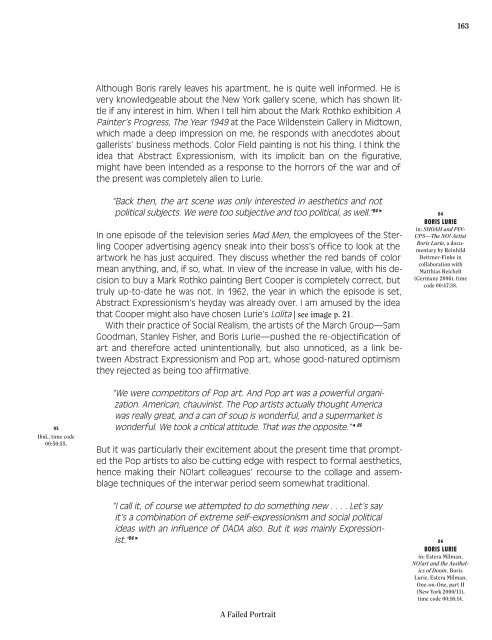The Art of
Katalog_Boris-Lurie_English
Katalog_Boris-Lurie_English
Create successful ePaper yourself
Turn your PDF publications into a flip-book with our unique Google optimized e-Paper software.
163<br />
Although Boris rarely leaves his apartment, he is quite well informed. He is<br />
very knowledgeable about the New York gallery scene, which has shown little<br />
if any interest in him. When I tell him about the Mark Rothko exhibition A<br />
Painter’s Progress, <strong>The</strong> Year 1949 at the Pace Wildenstein Gallery in Midtown,<br />
which made a deep impression on me, he responds with anecdotes about<br />
gallerists’ business methods. Color Field painting is not his thing. I think the<br />
idea that Abstract Expressionism, with its implicit ban on the figurative,<br />
might have been intended as a response to the horrors <strong>of</strong> the war and <strong>of</strong><br />
the present was completely alien to Lurie.<br />
“Back then, the art scene was only interested in aesthetics and not<br />
political subjects. We were too subjective and too political, as well.” 04<br />
In one episode <strong>of</strong> the television series Mad Men, the employees <strong>of</strong> the Sterling<br />
Cooper advertising agency sneak into their boss’s <strong>of</strong>fice to look at the<br />
artwork he has just acquired. <strong>The</strong>y discuss whether the red bands <strong>of</strong> color<br />
mean anything, and, if so, what. In view <strong>of</strong> the increase in value, with his decision<br />
to buy a Mark Rothko painting Bert Cooper is completely correct, but<br />
truly up-to-date he was not. In 1962, the year in which the episode is set,<br />
Abstract Expressionism’s heyday was already over. I am amused by the idea<br />
that Cooper might also have chosen Lurie’s Lolita | see image p. 21.<br />
With their practice <strong>of</strong> Social Realism, the artists <strong>of</strong> the March Group—Sam<br />
Goodman, Stanley Fisher, and Boris Lurie—pushed the re-objectification <strong>of</strong><br />
art and therefore acted unintentionally, but also unnoticed, as a link between<br />
Abstract Expressionism and Pop art, whose good-natured optimism<br />
they rejected as being too affirmative.<br />
04<br />
BORIS LURIE<br />
in: SHOAH and PIN-<br />
UPS—<strong>The</strong> NO!-<strong>Art</strong>ist<br />
Boris Lurie, a documentary<br />
by Reinhild<br />
Dettmer-Finke in<br />
collaboration with<br />
Matthias Reichelt<br />
(Germany 2006), time<br />
code 00:47:38.<br />
05<br />
Ibid., time code<br />
00:50:55.<br />
“We were competitors <strong>of</strong> Pop art. And Pop art was a powerful organization.<br />
American, chauvinist. <strong>The</strong> Pop artists actually thought America<br />
was really great, and a can <strong>of</strong> soup is wonderful, and a supermarket is<br />
wonderful. We took a critical attitude. That was the opposite.” 05<br />
But it was particularly their excitement about the present time that prompted<br />
the Pop artists to also be cutting edge with respect to formal aesthetics,<br />
hence making their NO!art colleagues’ recourse to the collage and assemblage<br />
techniques <strong>of</strong> the interwar period seem somewhat traditional.<br />
“I call it, <strong>of</strong> course we attempted to do something new . . . . Let’s say<br />
it’s a combination <strong>of</strong> extreme self-expressionism and social political<br />
ideas with an influence <strong>of</strong> DADA also. But it was mainly Expressionist.”<br />
06<br />
06<br />
BORIS LURIE<br />
in: Estera Milman,<br />
NO!art and the Aesthetics<br />
<strong>of</strong> Doom. Boris<br />
Lurie, Estera Milman,<br />
One-on-One, part II<br />
(New York 2000/11),<br />
time code 00:16:14.<br />
A Failed Portrait



